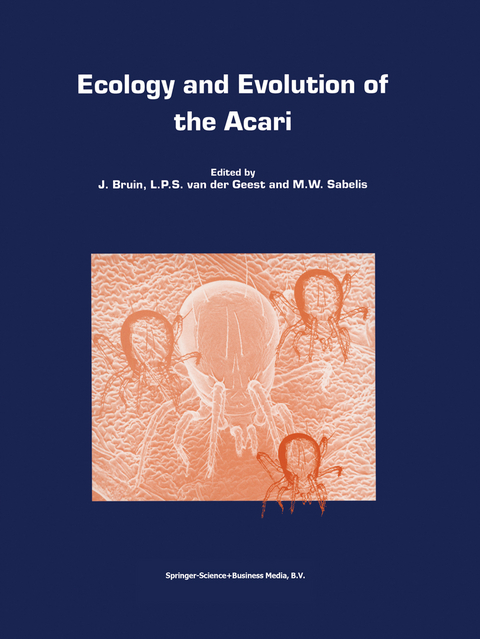
Ecology and Evolution of the Acari
Springer (Verlag)
978-90-481-5200-1 (ISBN)
Evolution and systematics of the Chelicerata.- Canalized pathways of change and constraints in the evolution of reproductive modes of microarthropods.- Morphological evidence for the evolutionary origin of Astigmata (Acari: Acariformes).- Evolution of phytophagy in trombidiform mites.- Origin and evolution of feather mites (Astigmata).- Phylogeny and co-speciation in feather mites of the subfamily Avenzoariinae (Analgoidea: Avenzoariidae).- Loss of larval parasitism in parasitengonine mites.- Life-history evolution in Parasitengonae (Acari: Prostigmata): constraints on number and size of offspring.- Sperm competition in the Acari.- Distribution of asymmetrical and symmetrical sperm storage in the Eriophyoidea and its phylogenetic implications.- Host plant associations in the spider mite Tetranychus urticae (Acari: Tetranychidae): insights from molecular phylogeography.- Genetic differentiation in Tetranychus urticae (Acari: Tetranychidae) from greenhouses in France.- The role of adaptation to host plants in the evolution of reproductive isolation: Negative evidence from Tetranychus urticae.- Geographic differences in host specialization between the symbiotic water mites Unionicola formosa and U. foili (Acari: Unionicolidae).- Interactions between arthropod predators and plants: A conspiracy against herbivorous arthropods?.- Behaviour and indirect interactions in food webs of plant-inhabiting arthropods.- Behavioural ecology of plant—phytoseiid interactions mediated by herbivore-induced plant volatiles.- The ecology of Lyme borreliosis vector ticks.- Biology and ecology of trombidiid mites (Acari: Trombidioidea).- Reflections on the biology, morphology and ecology of the Macrochelidae.- Phoresy by Hemisarcoptes (Acari: Hemisarcoptidae) on Chilocorus (Coleoptera:Coccinellidae): Influence of subelytral ultrastructure.- When to leave the brood chamber? Routes of dispersal in mites associated with burying beetles.- Functional morphology as an aid in determining trophic behaviour: The placement of astigmatic mites in food webs of water-filled tree hole communities.- Natural selection of Varroa jacobsoni explains the differential reproductive strategies in colonies of Apis cerana and Apis mellifera.- Regaining the water: a simulation model approach for Arrenurus larvae (Hydrachnellae) parasitizing damselflies (Coenagrion puella: Odonata).- Juvenile survival and development in Euseius finlandicus, Typhlodromus pyri and Kampimodromus aberrans (Acari: Phytoseiidae) feeding on con- and heterospecific immatures.- Do western flower thrips avoid plants infested with spider mites? Interactions between potential competitors.- Food and feeding behaviour of deutonymphs and adults of the water mite Hydrachna skorikowi (Acari: Hydrachnellae), with notes on the structure of their mouthparts.- Leaf hairs influence searching efficiency and predation rate of the predatory mite Phytoseiulus persimilis (Acari: Phytoseiidae).- Life-history parameters of two closely related forms of the Tetranychus urticae-complex on different host plants.- The contribution of extrafloral nectar to survival and reproduction of the predatory mite Iphiseius degenerans on Ricinus communis.- Pollen as a medium for rearing plant-feeding acarid mites (Acari: Acaridae).- Bionomics of Carpoglyphus lactis (Acari: Carpoglyphidae) on honey.- Mass-rearing of Amblyseius californicus (Acari: Phytoseiidae) on two alternative food sources.- The influence of various kinds of food on the distribution and life cycle of Metarhombognathus armatus (Halacaridae: Rhombognathinae).- Populationbiology of a phytophagous mite of marine and estuarine rocky shores (Astigmata, Hyadesiidae).- Diel and seasonal drift of water mites (Acari, Hydrachnidia) in two streams of the North German Lowland.- Water mites (Acari: Hydrachnidia, Halacaridae) from the hyporheic habitat of the Mugnone stream (Tuscany, Italy).- Water mites of typical habitats in four Polish national parks situated in different landscapes.- Remarks on the morphology, life cycle, distribution and taxonomy of water mites of the subfamily Acherontacarinae in the Western Palaearctic.- Water mites of small boreal forest lakes (Central Finland).- Presence of acetabula-like structures on the coxae of the neotropical water mite genus Neotyrrellia (Tyrrelliinae, Limnesiidae, Prostigmata).- Oribatid mites of the Galápagos Islands: Faunistics, ecology and speciation.- Gamasina in a succession of thirteen years.- Oribatid mites of a riverine forest in the Central Alps (Austria).- Comparison of adult oribatid mites (Acari, Oribatida) from three mountain forests in Poland: I. Abundance, biomass and species richness.- Compact aggregation and life history strategy in a continental Antarctic mite.- A biometrical study of Berniniella serratirostris (Acari: Oribatei) and some related species.- Morphological variability in populations of a thelytokous mite, Trhypochthoniellus longisetus (Oribatida), with notes on synonymy.- Fine structure of the humeral organ of juvenile Edwardzetes edwardsii (Ceratozetidae, Oribatida).- Observations on the fine structure of the vagina of pergamasid mites (Pergamasidae, Parasitina, Gamasida).- Ultrastructural cell modification in tomato (Lycopersicon esculentum) leaf tissue in response to the carmine spider mite (Tetranychus cinnabarinus) feeding.- Influence of soil management on mitepopulations in a vineyard agroecosystem.- Overwintering of phytoseiid mites (Parasitiformes, Phytoseiidae) on hazelnut (Corylus avellana) in Sicily (Italy).- Prosomal glands in Typhlodromus spp. females (Mesostigmata: Phytoseiidae).- Allergenic mites associated with bird nests in Poland (Astigmata: Pyroglyphidae, Acaridae, Glycyphagidae).- Body weight characteristics of some ixodid ticks: Reflecting adaptations to conditions of their habitats?.- Species validity of the soft-tick Argas polonicus (Acari: Argasidae) based on 16S rDNA sequence analysis.
| Reihe/Serie | Series Entomologica ; 55 |
|---|---|
| Zusatzinfo | 246 Illustrations, black and white; XII, 677 p. 246 illus. |
| Verlagsort | Dordrecht |
| Sprache | englisch |
| Maße | 210 x 279 mm |
| Themenwelt | Naturwissenschaften ► Biologie ► Evolution |
| Naturwissenschaften ► Biologie ► Ökologie / Naturschutz | |
| Naturwissenschaften ► Biologie ► Zoologie | |
| ISBN-10 | 90-481-5200-3 / 9048152003 |
| ISBN-13 | 978-90-481-5200-1 / 9789048152001 |
| Zustand | Neuware |
| Haben Sie eine Frage zum Produkt? |
aus dem Bereich


